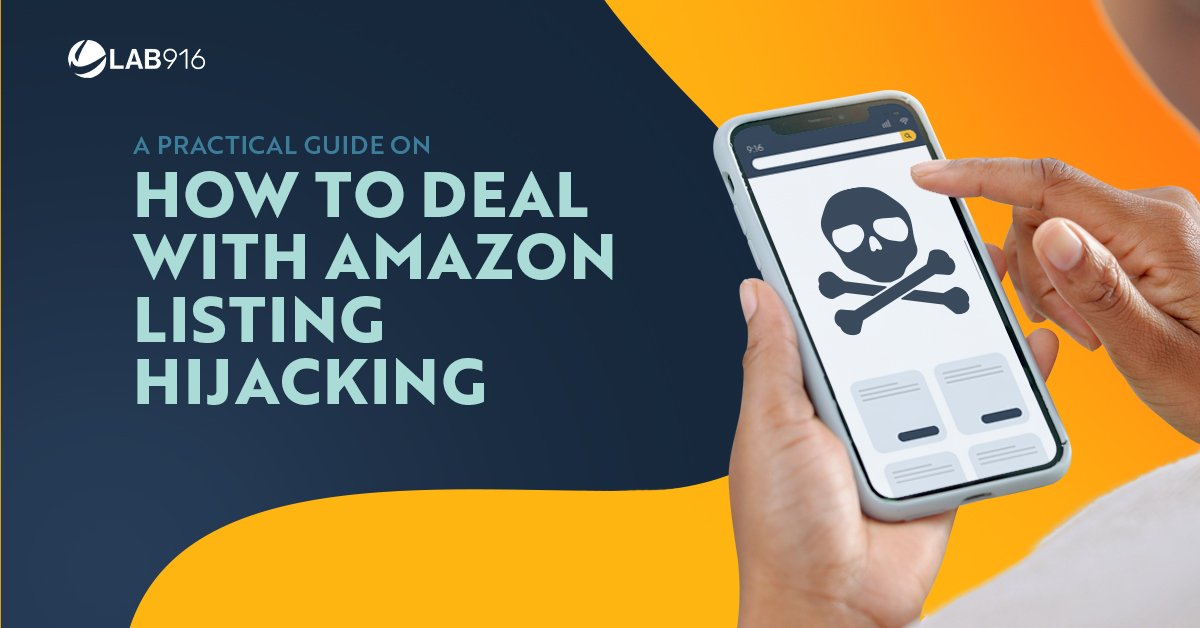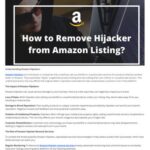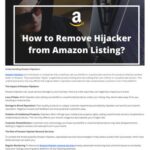You can tell if your Amazon listing is hijacked by noticing unapproved sellers or changes in product details. Lower prices or negative reviews might also indicate hijacking.
Amazon listing hijacking occurs when unauthorized sellers take over your product listing. This can lead to lost sales, damaged reputation, and customer confusion. Sellers may change product descriptions, images, or offer counterfeit products. Monitoring your listings regularly is crucial to detect any sudden changes.
Use Amazon Brand Registry to protect your listings. Always ensure your product details are accurate and up-to-date. Quick action can prevent long-term damage. Stay vigilant to maintain control over your listings and protect your brand.
Recognizing Listing Hijacking
Recognizing listing hijacking on Amazon is crucial for protecting your business. A hijacked listing can damage your brand and profits. Learn to identify the signs early to take swift action.
Common Signs
Several common signs can indicate your Amazon listing is hijacked:
- Price Drop: A sudden drop in price could signal hijacking.
- Buy Box Loss: Losing the Buy Box to an unknown seller is a red flag.
- Negative Reviews: An influx of bad reviews can be a sign.
- Changes in Product Details: Alterations in description, images, or features.
- Stock Issues: Your product shows ‘out of stock’ unexpectedly.
Examples
Here are some examples to help you recognize listing hijacking:
| Sign | Example |
|---|---|
| Price Drop | Your item usually sells for $30, now listed at $15. |
| Buy Box Loss | An unknown seller is now in the Buy Box. |
| Negative Reviews | Sudden negative reviews mentioning poor quality or wrong product. |
| Changes in Product Details | Product images or descriptions have been altered. |
| Stock Issues | Your product shows out of stock, but you have inventory. |
Impact On Your Business
Amazon hijackers can harm your business. They can hurt your sales and reputation. Identifying and addressing hijackers quickly is vital for your success.
Sales Decline
Hijackers can cause a sharp drop in your sales. They might sell counterfeit versions of your product at lower prices. This can drive potential buyers away from your genuine listing. Buyers may opt for cheaper alternatives, thinking they are buying from you. This can lead to significant revenue loss.
Here are some signs of sales decline due to hijacking:
- Sudden decrease in daily sales
- Increased returns and complaints
- Lower conversion rates
| Sign | Description |
|---|---|
| Sudden decrease in daily sales | Sales drop without any change in marketing efforts |
| Increased returns and complaints | Customers report receiving low-quality or different products |
| Lower conversion rates | Fewer buyers convert despite consistent traffic |
Brand Reputation
Hijackers can also damage your brand reputation. They may provide poor-quality products under your brand name. This can lead to negative reviews and poor ratings. Customers might blame your brand for the bad experience.
Negative effects on brand reputation can include:
- Decreased customer trust
- Negative reviews
- Lower overall ratings
Protecting your brand reputation is crucial. Customers need to trust your products. Regularly monitor your listings. Act quickly to remove hijackers.
Investigating Unauthorized Sellers
Investigating unauthorized sellers on your Amazon listing is crucial. Unauthorized sellers can harm your brand and reduce your sales. Knowing how to spot them helps protect your business.
Seller Metrics
Seller metrics can reveal unauthorized sellers. Check seller ratings and feedback. Authorized sellers usually have high ratings. Unauthorized sellers often have low ratings and negative feedback. Use Amazon’s Seller Central to view detailed metrics.
| Metric | Description |
|---|---|
| Feedback Score | Shows customer satisfaction. Lower scores indicate potential unauthorized sellers. |
| Order Defect Rate | High rates suggest poor quality, often linked to unauthorized sellers. |
| Response Time | Slow response times can indicate unauthorized sellers. |
Product Quality
Product quality is a key indicator. Check customer reviews for quality complaints. Authorized sellers maintain high-quality standards. Unauthorized sellers often sell inferior products. Look for common issues such as:
- Broken items
- Incorrect descriptions
- Poor packaging
Customers often report these issues in reviews. Use Amazon’s review section to identify problems. Consistent complaints can signal unauthorized sellers. Protect your brand by monitoring product quality.

Credit: lab916.com
Preventive Measures
Protecting your Amazon listing from hijackers is crucial. Implementing preventive measures ensures your products stay safe. Here are some strategies to keep hijackers at bay.
Brand Registry
Joining Amazon’s Brand Registry is essential. It offers several benefits:
- Enhanced brand protection: Brand Registry helps protect your brand.
- Access to powerful tools: You get advanced search and reporting tools.
- Improved brand content: You can create richer product detail pages.
To enroll, ensure you have a registered trademark. Follow Amazon’s guidelines for a smooth registration process.
Unique Packaging
Using unique packaging can deter hijackers. Here are some tips:
| Tip | Details |
|---|---|
| Custom designs | Use custom packaging designs that are hard to replicate. |
| Brand logos | Include your brand logo prominently on the packaging. |
| Security features | Incorporate security features like holograms or seals. |
Distinctive packaging makes it harder for hijackers to copy your products. It also helps customers identify your genuine items.
Monitoring Your Listings
When it comes to protecting your Amazon listings, monitoring them regularly is crucial. By keeping a close eye on your listings, you can quickly detect any signs of hijacking and take necessary actions to safeguard your products.
Automated Tools
Utilize automated tools like Jungle Scout or Sellics to keep track of your Amazon listings. These tools can provide real-time alerts and notifications if any unauthorized changes are made to your product listings.
Manual Checks
Perform manual checks on your listings by comparing the product details, images, and pricing with what you have originally set. Look for any discrepancies or unfamiliar changes that may indicate a hijacking attempt.

Credit: sellermetrics.app
Reporting Hijackers
Suspecting that your Amazon listing is hijacked can be stressful. The first step to reclaim your listing is to report the hijackers. This process involves contacting Amazon support and, if necessary, taking legal action. Let’s explore how to address these issues efficiently.
Amazon Support
Amazon’s support team is your first line of defense. They can help resolve hijacking issues. Follow these steps to report a hijacker:
- Log into your Amazon Seller Central account.
- Navigate to the ‘Help’ section.
- Click on ‘Contact Us.’
- Select ‘Report a Violation.’
- Fill out the form with relevant details.
Provide evidence like screenshots or order numbers. This will support your claim. Ensure your complaint is clear and concise. Here are some tips for effective reporting:
- Include the ASIN of the affected product.
- Provide details of the hijacker’s listing.
- Mention any customer complaints received.
- Attach any relevant documents or images.
After submitting your report, Amazon will investigate. They may take a few days to respond. Patience is key during this period.
Legal Action
If Amazon support doesn’t resolve the issue, consider legal action. This step can protect your brand and business. Here are the steps to take legal action:
- Gather all evidence of hijacking.
- Consult with an intellectual property attorney.
- Send a cease-and-desist letter to the hijacker.
- File a lawsuit if necessary.
Legal action can be time-consuming and costly. Ensure you have a strong case before proceeding. A table below outlines the pros and cons of legal action:
| Pros | Cons |
|---|---|
| Protects your brand integrity. | Can be expensive. |
| Deters future hijackers. | Time-consuming process. |
| Legal recourse for damages. | Requires strong evidence. |
Deciding to take legal action is significant. Weigh the pros and cons carefully. Consult a professional to guide you through the process.
Restoring Your Listing
Once you suspect your Amazon listing has been hijacked, restoring it becomes crucial. This process involves a few key steps to ensure your product regains its rightful place. Here’s how you can regain control and update your listing information efficiently.
Regaining Control
To regain control of your hijacked listing, follow these steps:
- Contact Amazon Support: Immediately report the issue to Amazon’s support team. Provide detailed information about the hijack.
- Provide Proof of Ownership: Submit documents that prove you are the rightful owner. These may include invoices, trademark certificates, or brand registry details.
- Monitor Your Listings: Keep a close eye on your listings regularly. Use tools to track unauthorized changes or suspicious activities.
Updating Information
Once you have regained control, update your listing information to prevent future hijacks. Follow these steps:
- Change Your Password: Ensure your Amazon seller account password is strong and unique.
- Update Product Details: Check and correct any changes made to your product title, description, and images.
- Set Up Alerts: Use Amazon’s notification settings to alert you of any listing changes.
Regularly updating and monitoring your Amazon listings helps maintain control. Stay vigilant to protect your business.
Long-term Strategies
Detecting a hijacked Amazon listing requires vigilance and proactive measures. Implementing long-term strategies can help safeguard your brand. These strategies not only protect your listings but also build customer trust. Below are some effective long-term strategies.
Enhanced Brand Content
Utilize Enhanced Brand Content to make your listings stand out. This feature allows you to add rich media like images and videos. It enhances your product descriptions and boosts customer engagement. Unique content makes it harder for hijackers to duplicate your listings.
EBC also helps improve your SEO rankings. Search engines favor rich, detailed content. This way, your products appear higher in search results. Higher visibility deters hijackers from targeting your listings.
Customer Engagement
Building strong customer engagement is key to brand protection. Engage with your customers through reviews and questions. Prompt responses show that you care about customer feedback. This builds loyalty and trust in your brand.
Encourage satisfied customers to leave positive reviews. More reviews make it easier to spot counterfeit products. Loyal customers will alert you if they notice any discrepancies.
You can also use social media to engage with your audience. Share updates, promotions, and behind-the-scenes content. This keeps your brand fresh in customers’ minds and makes hijacking less likely.

Credit: www.redpoints.com
Frequently Asked Questions
How Does Someone Hijack An Amazon Listing?
Hijackers copy a legitimate Amazon listing, then sell counterfeit or low-quality products. They manipulate reviews and prices to mislead buyers.
How Do I Report A Hijacker On Amazon?
Report a hijacker on Amazon by visiting the “Contact Us” page. Select “Report a Violation. ” Provide necessary details, including ASIN and issue description. Amazon will investigate.
How Do You Remove Other Sellers From Your Amazon Listing?
To remove other sellers, report them for policy violations. Ensure your brand is registered with Amazon Brand Registry. Maintain strong seller performance metrics and use exclusive distribution agreements.
How To Check Amazon Seller?
To check an Amazon seller, visit their seller profile for ratings, reviews, and feedback from customers.
How Can I Identify Amazon Listing Hijacking?
To identify Amazon listing hijacking, monitor product details, sales, and customer complaints regularly.
What Are Common Signs Of Amazon Listing Hijacking?
Common signs include unauthorized changes in product info, price drops, negative reviews, and sales fluctuations.
Why Is It Crucial To Detect Listing Hijacking Early?
Early detection prevents revenue loss, maintains brand reputation, and protects customer trust on Amazon.
How Can Sellers Protect Their Amazon Listings From Hijacking?
Sellers can protect listings by using brand registry, monitoring product analytics, setting up alerts, and reporting violations promptly.
Conclusion
Identifying an Amazon listing hijack is crucial for maintaining sales and reputation. Regularly monitor your listings for unauthorized changes. Stay vigilant and use Amazon’s Brand Registry for added protection. By taking these steps, you can safeguard your business from potential threats and ensure continued success on the platform.




